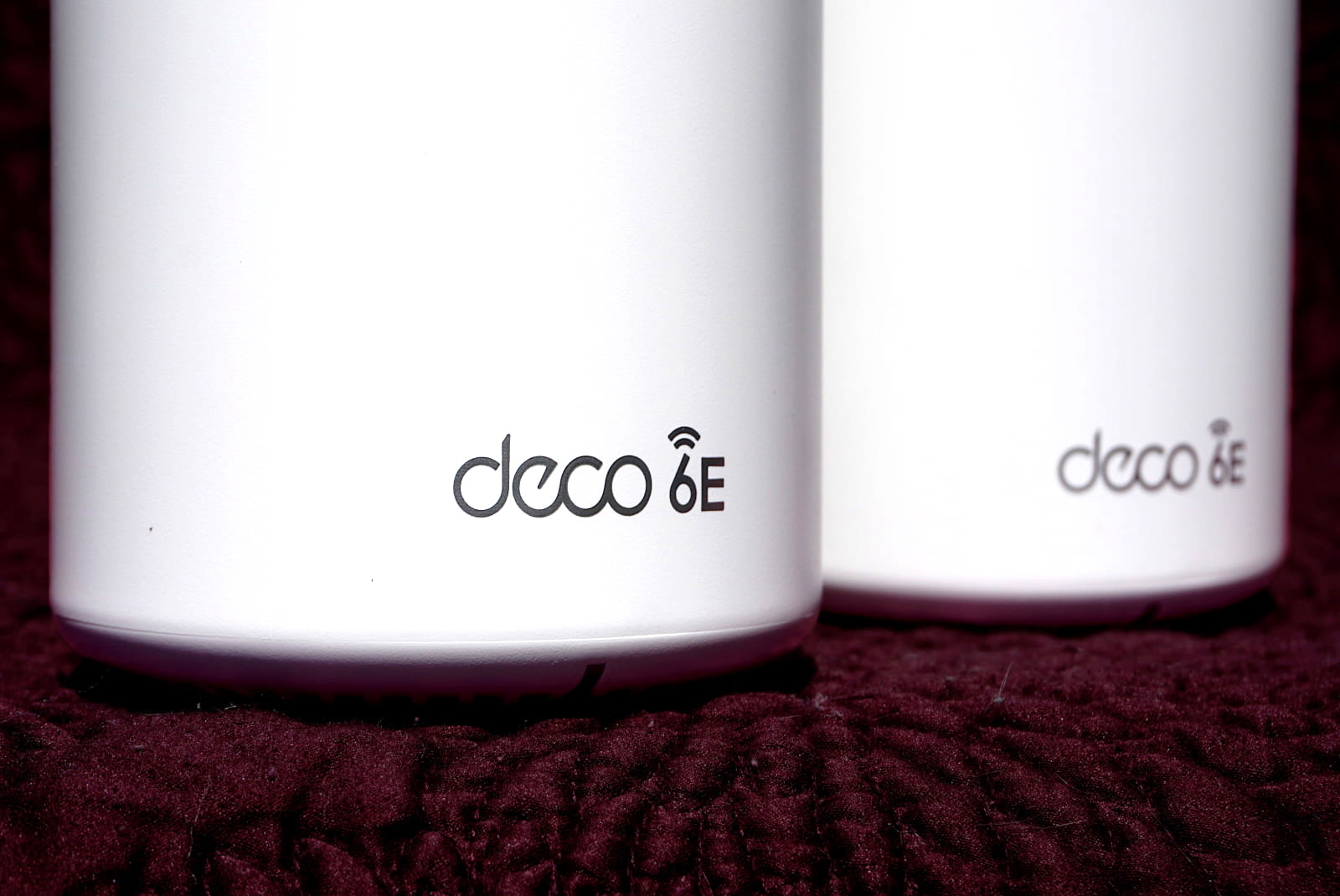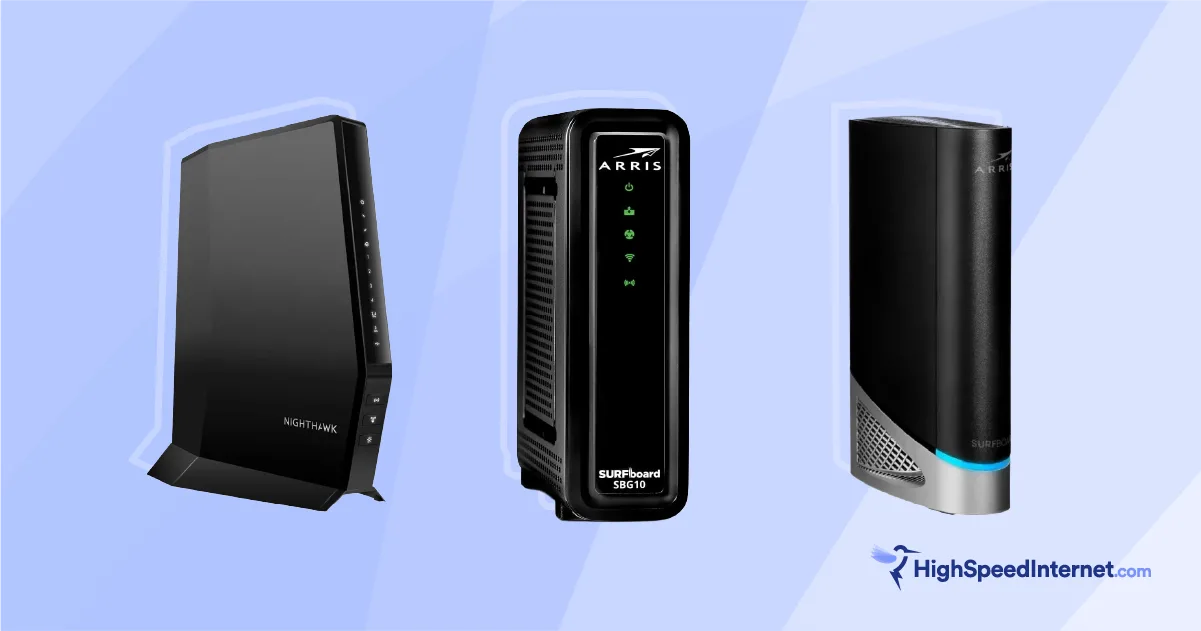TP-Link Deco XE75 Pro Review
The TP-Link Deco X75 Pro is one of the best mesh systems you can get.
Aug 1, 2025 | Share
Equipment Guides, Product Reviews, Router Reviews
*Amazon.com price (as of 2/14/25 16:30 MST). Read full disclaimer.

The Deco XE75 Pro is one of the best systems we’ve tested to date. Kevin Parrish | HighSpeedInternet.com
Is the Deco XE75 Pro right for you?
The TP-Link Deco XE75 Pro is a great system to have, even if you don’t pay for a multi-gig internet connection. Its biggest selling point is the third band accessing the new 6 GHz spectrum, but you don’t necessarily need a Wi-Fi 6E device to enjoy the speeds the XE75 Pro brings to your home network. It also has a few unexpected surprises under the hood, making it one of our favorite mesh systems to date.
 Pros:
Pros:
- Built-in VPN tools
- IoT networking
- Device isolation
 Cons:
Cons:
- Subscription-locked features
- Limited number of streams
- No USB connectivity
Check your speed: 2.3Gbps internet and slower required
You can use any of the three Ethernet ports for internet—the system automatically detects your connection. But what makes this system a “pro” model is its 2.5Gbps Ethernet port you can use for internet or a wired connection of up to 2,370Mbps (give or take). To see if you have the best internet speeds for the Deco XE75 Pro, run our speed test first:
You can also install our mobile apps to test your speed on a smartphone!
On this page:
Standout features | Competitor comparisons | Scoring breakdown | Our verdict | FAQ | Methodology
On this page:
Deco XE75 Pro standout features

You don’t need a Wi-Fi 6E device to use the Deco XE75 Pro system. Kevin Parrish | HighSpeedInternet.com
The Deco XE75 Pro has a few more features than all the other mesh systems we’ve tested to date, which is nice.
Compare the Deco XE75 Pro to the competition
| Product | Wi-Fi version | Max throughput | Price* | Order online |
|---|---|---|---|---|
| TP-Link Deco XE75 Pro | Wi-Fi 6E | 5,400Mbps | $199.99 | View on Amazon |
| TP-Link Deco X50-PoE | Wi-Fi 6 | 3,000Mbps | $249.99 | View on Amazon |
| TP-Link Deco X55 | Wi-Fi 6 | 3,000Mbps | $179.99 | View on Amazon |
| Amazon Eero Pro 6 | Wi-Fi 6 | 4,200Mbps | $399.99 | View on Amazon |
| NETGEAR Nighthawk MK83 | Wi-Fi 6 | 3,600Mbps | $299.97 | View on Amazon |
*Amazon.com prices (as of 2/14/25 16:30 MST). Read full disclaimer.
The Deco XE75 Pro is the only mesh system on the list that accesses the 6 GHz spectrum. By default, it uses this connection for Deco-to-Deco communication, while the Nighthawk MK83 has a third dedicated line with slower 5 GHz speeds. The Eero Pro 6 has three bands, too, but it picks the best one for Eero-to-Eero communication versus locking one down solely for internal use like the XE75 and MK83.
If multi-gig internet is what you need, the Deco XE75 Pro supports that, too: up to 2,370Mbps. TP-Link’s Deco X50-PoE system also has a 2.5Gbps Ethernet port, but you can use Ethernet to supply power to each X50-PoE unit, whereas you can’t with the Deco XE75 Pro. The power-over-Ethernet feature is handy if you need to install a satellite in areas without a power outlet.
See our full coverage of the best mesh systems and routers.
Our Deco XE75 Pro scoring breakdown
| Category | Score* | Summary |
| Performance | 4 | Has some of the best speeds we’ve tested for a mesh system. |
| Features | 5 | Packs VPN tools, IoT networking, and more. |
| Design | 4 | Includes a third 6 GHz band for Deco-to-Deco use. |
| Setup | 4 | Gets you up and running quickly. |
| Ease of use | 5 | Makes network management easy through the Deco app. |
* out of 5 points

The Deco XE75 Pro includes built-in VPN tools to keep you anonymous online. Kevin Parrish | HighSpeedInternet.com
Performance |
4 |
We almost gave the XE75 Pro a perfect score in performance. In fact, we probably should, given what we recorded from the satellite. But the lack of channel selection control is problematic and reduces the score. In short, your speeds depend wholly on the channel the AI selects, which may or may not be optimal for your setting.
Still, there are some really good speeds to be had with the XE75 Pro based on our tests. Its 5 GHz speeds are mostly on par with other Wi-Fi 6 mesh systems we’ve tested to date, including the Deco X50-PoE, NETGEAR’s Nighthawk MK83, and Amazon’s Eero Pro 6.
For example, when we measure speeds with an iPhone, mesh systems usually start around 850Mbps at close range. Check out the close-range averages we recorded with the XE75 Pro:
| Apple iPhone 12 Pro Max* | Lenovo ThinkPad† | Google Pixel 6† | |
|---|---|---|---|
| Ceiling speed | 1,200 | 2,400 | 2,400 |
| Connection | 5 GHz | 5 GHz | 6 GHz |
| Speed @ 2 ft. | 829 | 1,120 | 1,590 |
* Speeds in megabits per second (Mbps) using an 80 MHz channel.
† Speeds in megabits per second (Mbps) using a 160 MHz channel.
However, the speed averages become less similar as we move away from the router unit and our iPhone transitions to the satellites. Here is where a third band dedicated to router-to-satellite communication plays a vital role in how these systems provide faster whole-home speeds than those that don’t.
And with the Deco XE75 Pro, there’s an even more noticeable difference when we compare its satellite speeds to the competition. We go into detail in the FAQ if you want to know more, but the bottom line is you don’t need Wi-Fi 6E devices to use this system. The connection is primarily used as your Wi-Fi backbone, so you’re not snaking Ethernet everywhere to get the fastest speeds possible from each Deco unit.

The Deco XE75 Pro looks great in any setting in your home or office. Kevin Parrish | HighSpeedInternet.com
Features |
5 |
For a mesh system, the XE75 Pro deserves a perfect score. First, it includes a built-in VPN server and client, which is rare for a mesh system. You can use the server to remotely access your home network or use it to surf the internet anonymously while you’re away from home. The client works with any VPN subscription service to protect devices that don’t support VPN software.
Next, you can create a separate network for your IoT devices. This feature produces a different SSID and password and isolates your IoT gadgets from all the other devices connected to your primary network.
Device isolation is a similar feature, only you don’t create a separate network. Instead, you can group specific devices so they don’t communicate with other non-isolated ones. This feature is probably best used if you’re hosting an FTP server that’s accessible from the internet.
Rounding out the features list is its compatibility with Amazon Alexa and Google Assistant, and its built-in support for TP-Link Tapo, TP-Link Kasa, and Philips Hue smart devices. You can check out experimental features, too, like the new Wi-Fi Assistant now available in the app’s Deco Lab section.
What we wish the Deco XE75 Pro did better
- Free security and full parental controls
- USB connectivity
Unlike many standalone routers, mesh systems often stand in as a way to sell security and parental control services. The XE75 Pro has some great free parental controls, but things like custom bedtimes and internet time limits require a subscription. The XE75 Pro offers some basic security, too, but you need a subscription for web, intrusion, and IoT protection features.
And while mesh systems never include USB ports (at least, not the ones we’ve tested), we’d still like to see USB connectivity for sharing files and streaming stored media locally across the network. Maybe one day, components will get small enough to allow a USB port to fit on the Deco’s motherboard.

Each Deco XE75 Pro unit includes two Gigabit Ethernet ports (top) and one 2.5Gbps Ethernet port (bottom). Kevin Parrish | HighSpeedInternet.com
Design |
4 |
So, there are two huge design wins with the XE75 Pro, starting with the added 2.5Gbps Ethernet port, which isn’t included in the vanilla XE75 model. This port is a big deal since the XE75 Pro supports superwide channels and the new 6 GHz band. It allows you to fully utilize a 1,000Mbps internet connection versus a Gigabit Ethernet WAN port that limits your top speeds to around 940Mbps. This port also complements the high real-world wireless speeds you can get using 160 MHz channels—we explain why in our FAQ.
The second callout is the 6 GHz band. It’s a new(ish) spectrum with new channels that enable real-world wireless gigabit speeds. By default, the XE75 Pro uses this band as a dedicated connection for Deco-to-Deco communication (called the backhaul). If you don’t have Wi-Fi 6E devices, then you’d keep this private road enabled as-is. If you do have W-Fi 6E devices, you can toggle on the Wi-Fi Network & Backhaul mode so the XE75 Pro shares the 6 GHz connection with them.
The one major design flaw that keeps us from assigning a perfect score is the inability to change channels. After reviewing NETGEAR’s Nighthawk MK83 system, we know it’s possible, and we’re not sure why all mesh systems don’t have this function. The only thing you can do is toggle between 80 MHz and 160 MHz channel widths.
Setup |
4 |
Mesh network setups are generally pretty easy. Most of the systems we’ve reviewed come preconfigured, so all you do is set up the “router” model while all the other units join the new network automatically. The setup is a little longer than standalone router ones because mesh systems target a general audience that may not know how to power cycle a modem or connect the router unit.
That said, there’s nothing to report here. You shouldn’t have problems getting the XE75 Pro system up and running in no time flat. But remember that you need a free TP-Link ID account to use this system, so if you’re resistant to having yet another account to use a service or product… well, too bad (grin).

The most recent TP-Link Deco app makes network management simple. Kevin Parrish | HighSpeedInternet.com
Ease of use |
5 |
The XE75 Pro has a web interface, but don’t bother—it’s a barren landscape compared to other standalone routers and mesh systems. Everything you need resides in the Deco app, so you’ll probably never have a reason to log in through the web interface anyway.
The Deco app does an excellent job of spreading out and categorizing all your settings into four tabs. Most of the “hard core” settings reside under the More tab, while your most-used settings appear on the main Network tab, like changing the Wi-Fi settings, managing devices, and adding smart devices.
Are there any additional costs?
The optional HomeShield Pro subscription costs $5.99 per month or $54.99 per year. It includes the security and parental control features not offered through the free HomeShield Basic service.

The Deco XE75 Pro has excellent speeds thanks partly to the third 6 GHz connection. Kevin Parrish | HighSpeedInternet.com
Our Deco XE75 Pro review: The verdict
We can’t help but say good things about the Deco XE75 Pro. If you haven’t figured it out by now, the “pro” label only means this system has a 2.5Gbps Ethernet port for internet or wired networking, whereas the vanilla Deco XE75 version does not. If you have an internet plan of 940Mbps or slower, then the non-Pro version is a better fit for you.
Overall, mesh systems are usually bland in terms of features, so we were pleasantly surprised to see all the cool things the XE75 Pro has under the hood, like the VPN tools and the IoT device networking component. It even has more basic parental controls than what we’ve seen on competing systems.
Our only real big beef with the Deco XE75 Pro is you can’t change channels. Plus, if you leave the 6 GHz band as is, the system only supports up to four of your devices in any given second. Add more active devices to Wi-Fi and you introduce added latency and slower speeds. If you need lots of devices downloading simultaneously, then you may want to consider a standalone router with mesh support.
Still, it’s a good system to have if you need whole-home coverage. It has our highest review score to date, so keep the XE75 Pro in mind when you shop for your next home network centerpiece.
FAQ about the Deco XE75 Pro
Which Ethernet port do you use for internet?
Why is the 2.5Gbps an important addition?
How does the 6 GHz band improve whole-home speeds?
What’s the difference between HomeCare and HomeShield?
What parental controls are made available for free?
Methodology
We test router speed by setting up each router in an office and connecting it to a local test server. Then, we transmit test data between our wireless devices and the server, taking numerous measurements to account for fluctuations in Wi-Fi speeds.
The first tests occur close to the router, without obstructions—so the Wi-Fi is as strong and fast as it’s gonna get. We repeat the process straight out at 10, 20, and 30 feet, with only a glass door obstructing our view of the router. The same glass door and an exterior door blocks our path when we test outside at 40 and 50 feet.
We also run tests in a hallway to the left of the TV room and office—where there’s a glass door, three walls, and an air handler unit blocking our view of the router. The dining room, another testing point, sits to the right of the kitchen, TV room, and office—two walls and a glass door block the path in this test.
To test video streaming, we connect a fast storage device to the router and stream a 4K video to six wireless devices simultaneously—two phones, three tablets, and a laptop—connected to the same wireless band.
Client devices used in testing
| iPhone 12 Pro Max | Google Pixel 3 | |
|---|---|---|
| Wi-Fi version | Wi-Fi 6 | Wi-Fi 5 |
| Stream configuration | 2 x 2 | 2 x 2 |
| Max channel width | 80 MHz | 80 MHz |
| Max 5 GHz speed (AX) | 1,200 Mbps | – |
| Max 5 GHz speed (AC) | 866 Mbps | 866 Mbps |
| Max 2.4 GHz speed (AX) | 195 Mbps | – |
| Max 2.4 GHz speed (AC) | 195 Mbps | 144 Mbps |
Deco XE75 Pro benchmarks (5 GHz only)
| iPhone 12 Pro Max* | Google Pixel 3* | |
|---|---|---|
| 2 feet | 829 | 621 |
| 10 feet | 767 | 570 |
| 20 feet | 634 | 509 |
| 30 feet | 595 | 419 |
| 40 feet (porch) | 413 | 254 |
| 120 feet (across street) | 124 | 93 |
| 160 feet (mailboxes) | Not connected | Not connected |
| 20 feet (hallway) | 756 | 586 |
| 20 feet (dining room) | 785 | 551 |
* Speeds in megabits per second (Mbps) using an 80 MHz channel.
Disclaimer
Amazon.com Prices as of 2/14/25 16:30 MST. Product prices and availability are accurate as of the date/time indicated and are subject to change. Any price and availability information displayed on Amazon.com at the time of purchase will apply to the purchase of this product. Highspeedinternet.com utilizes paid Amazon links.
CERTAIN CONTENT THAT APPEARS ON THIS SITE COMES FROM AMAZON. THIS CONTENT IS PROVIDED ‘AS IS’ AND IS SUBJECT TO CHANGE OR REMOVAL AT ANY TIME.
Author - Kevin Parrish
Kevin Parrish has more than a decade of experience working as a writer, editor, and product tester. He began writing about computer hardware and soon branched out to other devices and services such as networking equipment, phones and tablets, game consoles, and other internet-connected devices. His work has appeared in Tom’s Hardware, Tom's Guide, Maximum PC, Digital Trends, Android Authority, How-To Geek, Lifewire, and others. At HighSpeedInternet.com, he focuses on network equipment testing and review.







